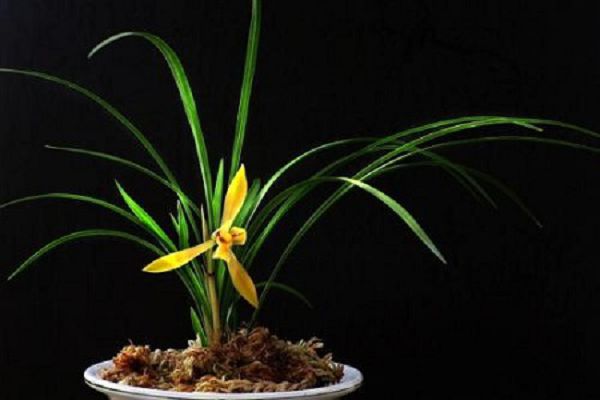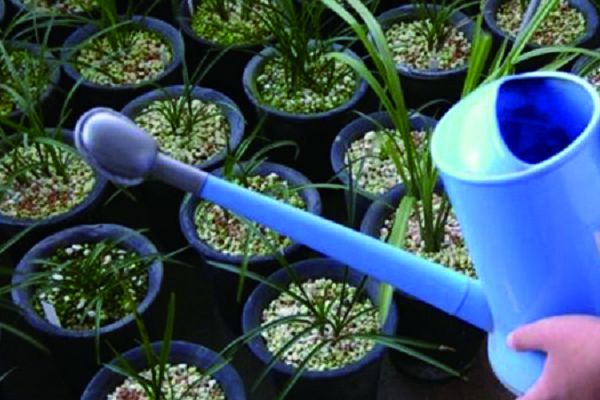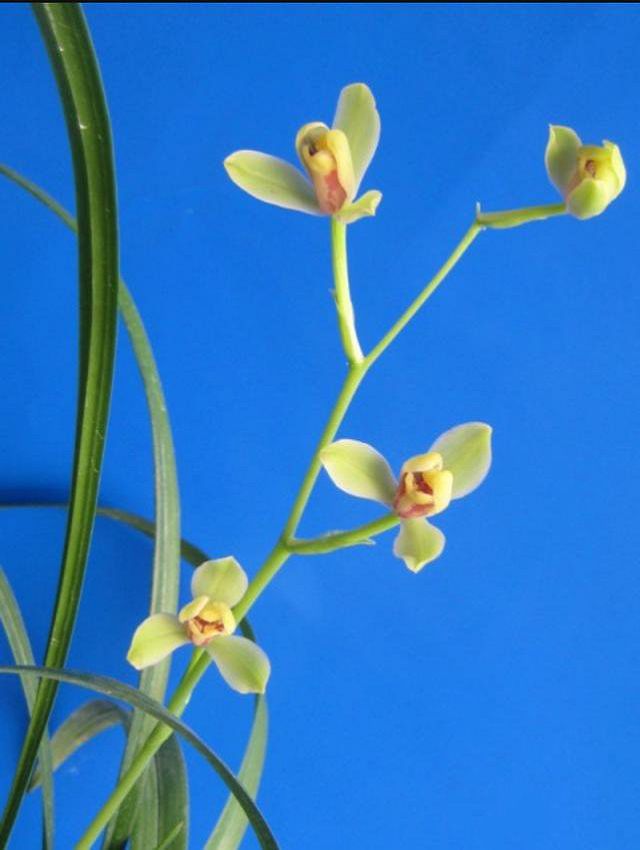Culture methods and matters needing attention of potted orchids

Orchid is not only a traditional precious flower in China, but also a famous flower in the world. People have always regarded orchids as a symbol of nobility and elegance, and together with plum, orchid, bamboo and chrysanthemum, they are called "four gentlemen". Orchid with delicate fragrance and chrysanthemum, daffodils, calamus also known as "flowers and plants four elegant", and orchid ranks first. The orchid is simple and unadorned, the leaf color is evergreen, the leaf quality is soft and firm, the flower fragrance is Qingyuan, it has extremely high ornamental value, it is the treasure of display living room, living room or adornment study, foyer. Many people like to plant orchids at home. Let's learn more about it.
I. Culture methods
1. Soil
To use acidic soil to grow it, not alkaline, if it is a special culture soil, it is best to use orchid mud, or with rotten leaves and garden soil mixed well.
2. Temperature
It needs an atmosphere of 15 to 25 degrees. If it is from March to October, it should be 18 to 25 degrees. If it is from October to March of the following year, it should be 10-18 degrees. Severe winter can withstand a low temperature of minus 5-8 degrees, but it is best to have 3-8 degrees. It can be placed on the window facing south, so that the soil in the basin will not freeze.
3. Watering
The amount of water should be determined according to different stages, different stages of growth and different atmosphere. During the severe winter, it suspends its growth and wants to control watering, usually once every 5-7 days, and the soil is a little wet. If the soil is dry, it should be sprayed with water close to the temperature in the house when the weather is fine, but it cannot be irrigated.
4. Fertilization
Do not use a large dose of fertilizer, it should be cooked first, you can use organic fertilizer or special fertilizer. When it grows buds, you only need to leave one of the healthiest and most beautiful buds, the rest can be cut off, and you can spray some special fertilizer for flowers, which can help it look more beautiful and prolong the time of flowering, and remove the flowers when they wither. Don't wait for it to fall naturally, which can reduce the loss of nutrients and make it easier to bloom in the coming year.
5. Insect pests
It is more prone to insect pests, such as shell insects, should be ventilated during maintenance, and the water permeability of the soil is better. If you are sick, you can use methyl topiramate to treat, if the situation is particularly serious, to replace the new soil and basin.
6. Lighting
Orchids like shade and are afraid of bright light, so they should be shaded in spring, summer and autumn. For family orchids, in order to control the amount of light, it is best to put them on the balcony windowsill or under the eaves with bamboo shade, generally shading from 9 am to 6 pm, and opening the curtain after 6 pm in the morning and after 6 pm to make it accept scattered sunlight. In winter, it should be moved to the place where the scattered light is visible indoors, but direct sunlight should also be avoided. The shade tolerance of orchids was the strongest, followed by Jian Lan, while Chunlan and Cymbidium were weaker.
7. Pruning
In the process of orchid culture, plant pruning should be carried out, such as when the old leaves are withered and yellow, which is beneficial to the growth of other leaves and can also be ventilated. On the other hand, the leaves with diseases need to be pruned in time to prevent infection. In addition, scissors also need to be disinfected to prevent infection.
8. Change the basin
Orchids grow slowly and can be changed every 1-2 years after the flowers fade. When putting on the basin, fill in tile grains, slag and so on about 3 cm at the bottom of the basin to facilitate drainage. Then, put into a layer of culture soil, and then put the orchid seedling into the middle of the basin, straighten the root straight and let it stretch naturally. Gently lift the orchid seedling in the middle of the filling, shake the flowerpot at the same time, so that the soil is closely combined with the root, when filling the soil 2cm away from the mouth of the basin, gently press it with your hand.
II. Matters needing attention in orchid culture
1. Orchids are mainly distributed in the southeast and southwest. More wild in the moist valley under the sparse forest and rock edge of the shade, so like warm, humid climate, like shade and dampness, require a shade of 70% to 90%, avoid high temperature, dryness and strong light.
2. The withered and yellow old leaves and disease and insect leaves should be cut off continuously in orchid cultivation to facilitate ventilation. After the flower buds are unearthed, each plant should leave a strong flower bud and the rest should be cut off so as not to consume too much nutrients and affect flowering in the coming year. After the flower fades, the flower stalk should be cut off.
3. Orchids should pay attention to cold protection in winter, terrestrial orchids have strong cold resistance, while orchids require higher overwintering temperature, so they should move indoors or use plastic sheds as soon as possible to avoid cold, and the room temperature should be kept at 10: 15 ℃. Indoor maintenance should pay attention to ventilation. The climate is getting warmer in spring, and gradually move the orchid to the courtyard or balcony.
4. Natural Rain Water, stream water, well water and river water are the best for orchid family cultivation. If tap water is used, it should be stored in a tank first, and then used after being exposed to the sun to remove bleach. If the flowers are watered with tap water for a long time, the cultivation substrate will be gradually alkalized.
5. During orchid culture, ferrous sulfate can be applied at regular intervals to increase soil acidity. In addition, watering orchids with fermented Amoy rice water can also keep the upper soil slightly acidic.
Morphological characteristics of orchids
Epiphytic or terrestrial herbs, rarely saprophytic, usually pseudobulbose; pseudobulbs ovoid, elliptic, or fusiform, rarely absent or extended into stem-like, usually enclosed in sheaths at the base of leaves. Leaves several to many, usually born on the base or lower nodes of pseudobulbs, distichous, banded or rarely oblanceolate to narrowly elliptic, base generally with broad sheaths and enclosing pseudobulbs, articulated.
Scape lateral or arising from the base of pseudobulb, erect, curved or pendulous; racemes with several or many flowers, rarely reduced to a single flower; bracts long or short, not falling at anthesis; flowers large or medium large; sepals free from petals, somewhat similar; labellum 3-lobed, base sometimes connate with core column to 3-6 mm; lateral lobes erect, often ±enclosing core column, middle lobes generally curved. There are 2 longitudinal folds on the labial disc, usually extending from the base to the base of the middle lobe, sometimes distally dilated or broken in the middle, less merged into one; the core column is longer, often more or less curved forward, winged on both sides, ventral sunken or sometimes with short hairs, 2 pollen clusters, with deep fissures, or 4 to form 2 pairs of unequal size, waxy, connected to the nearly triangular viscous disk with a very short, elastic pollen stalk.
The flowers commonly seen are composed of pedicels, receptacles, calyx, Corolla, gynoecium and stamens. Orchid is a kind of peculiar flower, and its peculiarity lies in its unique flower structure. The peculiar structure of orchid is to adapt to insect pollination, and has core column, stamen beak, pollen mass and labellum, etc., in addition, orchids are symmetrical flowers, the base of labellum forms sacs and distances with nectaries, the number of stamens decreases, ovaries are inferior, flowers are diverse in shape, size and color, and most of them are herbaceous, epiphytic or saprophytic.
Growth habits of orchids
Orchids originally grow in hilly areas or mountain springs, some in wooded valleys with sloping slopes, or in rocky crevices with deeper soil layers. Due to the different types of orchids, their living habits are also different. Spring orchid likes yin and summer orchid likes yang, but both like warm and humid climate. The root system of orchid is distributed on the surface of the soil layer, which requires that the soil layer is rich in humus and has good properties of loose texture, water permeability, fertilizer and water conservation. The soil is acidic and the pH value is between 5.5 and 6.5. Orchids most avoid soot, dust, but also afraid of hot sun and torrential rain, air pollution is not conducive to orchid growth, the root system must have orchid symbiosis, otherwise poor growth.
Distribution range of orchids
China has a vast territory, complex ecological environment and many types of vegetation, so orchid resources are very rich, which are distributed all over the country, but the quantity distribution decreases from south to north. The most species of orchids in China are Yunnan, Sichuan and Taiwan provinces.
In addition to Ningxia, Qinghai and Xinjiang in the north, northeast and northwest of China, there are different species of orchids in various provinces and regions of China. Generally speaking, terrestrial orchids are born in temperate and subtropical regions, such as Jiangsu, Anhui and Henan, while epiphytic orchids are born in tropical and subtropical regions, such as Guangdong, Fujian, Taiwan and so on.
Propagation methods of orchids
1. Ramet: it can be carried out in both spring and autumn, usually every three years. All plants with dense pseudocorms can be ramified, and at least 5 connected pseudocorms should be preserved in each clump. Irrigation should be reduced before dividing plants to make the basin soil drier. When putting on the basin after ramet, first cover the bottom hole of the basin with broken tiles, then cover the basin with coarse stones, occupy the basin depth of 5cm, 1ax, 4pm, then put coarse-grained soil and a small amount of fine soil, and then plant it with sandy loam rich in humus.
2. Sowing: the orchid seed is very fine, there is only one underdeveloped embryo in the seed, the germination power is very low, and the seed coat is not easy to absorb water, so it can not germinate by conventional sowing, so it is necessary to use orchid or artificial medium to supply nutrients to germinate.
The floral language of orchids
Orchids generally describe a gentleman and often describe a woman as an empty valley and an orchid.
Oncidium: hidden Love
Sword orchid: elegance, longevity, Corning
The flower language of orchids: indifferent, elegant, beautiful, noble and virtuous.
Related
- Is the orchid suitable for indoor use? Is it good for the body?
- How to prevent the empty root of orchids?
- What to do after the crab claw orchid is withered?
- Why are the leaves of orchids always yellow? Fertilizing and watering.
- Can the root of the gentleman orchid be saved if it is rotten?
- Diagnosis and treatment of cotton-blowing beetle insects in Cymbidium
- There is a way for a gentleman's orchid to rot.
- What is the most suitable temperature and humidity for the orchid?
- How to raise a gentleman's orchid? Cultivation techniques of Cymbidium
- How to prepare the nutritive soil for the cultivation of Cymbidium



